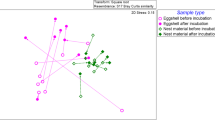Summary
The brush turkey (Alectura lathami) and mallee fowl (Leipoa ocellata) are megapode birds that incubate their eggs by burying them in mounds. Respiratory gas exchange between the buried eggs and the atmosphere occurs mainly by diffusion through about 60 cm of decomposing forest litter (brush turkey) or sand (mallee fowl).
Gas fluxes in the brush turkey mound are greatly influenced by the respiration of thermophilic microorganisms which consume O2 at rates over eight times that of all of the eggs. The respiratory exchange ratio (\(\dot V_{{\text{CO}}_{\text{2}} } / \dot V_{{\text{O}}_{\text{2}} } \)) of the microorganisms is 0.75 and theQ 10 for metabolism is 2.56. Fermentation and nitrogen fixation do not occur in the mounds.
If the mound becomes too wet, gas tensions near the eggs can become critical because water increases rates of microbial respiration and impedes gas diffusion. However, field mounds are relatively dry, possibly because the adult bird modifies the shape of the mound and affects the entry of rain water. At egg level in field mounds,\(P_{O_2 } \) and\(P_{{\text{CO}}_2 } \) are about 132 and 21 Torr, respectively, in both species. Embryonic respiration decreases\(P_{O_2 } \) and increases\(P_{{\text{CO}}_2 } \) about 5 Torr in the immediate environment of individual eggs in late development. Due to a high eggshell gas conductance, which increases during incubation, the gas tensions within the shell of late embryos (\(P_{O_2 } \) ca. 108 Torr,\(P_{{\text{CO}}_2 } \) ca. 47 Torr) are not far from the mean values found in species that nest above ground.
Similar content being viewed by others
References
Ackerman RA (1977) The respiratory gas exchange of sea turtle nests (Chelonia, Caretta). Respir Physiol 31:19–38
Ar A, Rahn H (1985) Pores in avian eggshells: gas conductance, gas exchange and embryonic growth rate. Respir Physiol 61:1–20
Ar A, Paganelli CV, Reeves RB, Greene DG, Rahn H (1974) The avian egg: water vapor conductance, shell thickness, and functional pore area. Condor 76:153–158
Baltin S (1969) Zur Biologie und Ethologie des Talegalla-Huhns (Alectura lathami Gray) unter besonderer Berücksichtigung des Verhaltens während der Brutperiode. Z. Tierpsychol 26:524–572
Birchard GF, Kilgore DL Jr (1980) Conductance of water vapor in eggs of burrowing and nonburrowing birds: implications for embryonic gas exchange. Physiol Zool 53:284–292
Birkinshaw JH (1965) Chemical constituents of the fungal cell. In: Ainsworth GC, Sussman AS (eds) The fungi, vol 1. Academic Press, London New York, pp 197–228
Bucher TL, Barnhart MC (1984) Varied egg gas conductance, air cell gas tensions and development inAgapornis roseicollis. Respir Physiol 55:277–289
Carey C (1980) Adaptation of the avian egg to high altitude. Am Zool 20:449–459
Fleay DH (1937) Nesting habits of the brush turkey. Emu 36:153–163
Frith HJ (1956) Breeding habits in the family Megapodiidae. Ibis 98:620–640
Frith HJ (1959) Breeding of the mallee fowl,Leipoa ocellata Gould (Megapodiidae). CSIRO Wildl Res 4:31–68
Frith HJ (1962) The mallee fowl. Angus and Robertson, Sydney
Hillel D (1971) Soil and water. Academic Press, New York San Francisco London
Kreith F (1973) Principles of heat transfer, 3rd edn. Intext Educational Publishers, New York
Leon-Velarde F, Whittembury J, Carey C, Monge C (1984) Permeability of eggshells of native chickens in the Peruvian Andes. In: Seymour RS (ed) Respiration and metabolism of embryonic vertebrates. Dr W. Junk Publishers, Dordrecht Boston London, pp 245–257
Lomholt JP (1976) Relationship of weight loss to ambient humidity of bird eggs during incubation. J Comp Physiol 105:189–196
Millington RJ (1959) Gas diffusion in porous media. Science 130:100–102
Paganelli CV, Ackerman RA, Rahn H (1978) The avian egg: in vivo conductances to oxygen, carbon dioxide, and water vapor in late development. In: Piiper J (ed) Respiratory function in birds, adult and embryonic. Springer, Berlin Heidelberg New York, pp 212–218
Paganelli CV, Rahn H (1984) Adult and embryonic metabolism in birds and the role of shell conductance. In: Seymour RS (ed) Respiration and metabolism of embryonic vertebrates. Dr W. Junk Publishers, Dordrecht Boston London, pp 193–204
Rahn H (1984) Factors controlling the rate of incubation water loss in bird eggs. In: Seymour RS (ed) Respiration and metabolism of embryonic vertebrates. Dr W. Junk Publishers, Dordrecht Boston London, pp 271–288
Scholander PF (1947) Analyzer for accurate estimation of respiratory gases in one-half cubic centimeter samples. J Biol Chem 167:235–237
Seymour RS (1985) Physiology of megapode eggs and incubation mounds. Acta XVIIIth Ornithological Congress, Moscow, pp 854–863
Seymour RS, Ackerman RA (1980) Adaptation to underground nesting in birds and reptiles. Am Zool 20:437–447
Seymour RS, Rahn H (1978) Gas conductance in the eggshell of the mound-building brush turkey. In: Piiper J (ed) Respiratory function in birds, adult and embryonic. Springer, Berlin Heidelberg New York, pp 243–246
Vleck D (1986) Measurement of oxygen consumption, carbon dioxide production and evaporative water loss in a closed system. J Appl Physiol (in press)
Vleck D, Vleck CM, Hoyt DF (1980) Metabolism of avian embryos: ontogeny of oxygen consumption in the Rhea and Emul. Physiol Zool 53:125–135
Vleck D, Vleck CM, Seymour RS (1984) Energetics of embryonic development in the megapode birds, mallee fowlLeipoa ocellata and brush turkeyAlectura lathami. Physiol Zool 57:444–456
Wangensteen OD, Wilson D, Rahn H (1970/71) Diffusion of gases across the shell of the hen's egg. Respir Physiol 11:16–30
Withers PC (1977) Measurement of\(\dot V_{{\text{O}}_{\text{2}} } , \dot V_{{\text{CO}}_{\text{2}} } \) and evaporative water loss with a flow through mask. J Appl Physiol: Respir Environ Exercise Physiol 42:120–123
Worth H, Piiper J (1978) Diffusion of helium, carbon monoxide and sulfur hexafluoride in gas mixtures similar to alveolar gas. Respir Physiol 32:155–166
Author information
Authors and Affiliations
Rights and permissions
About this article
Cite this article
Seymour, R.S., Vleck, D. & Vleck, C.M. Gas exchange in the incubation mounds of megapode birds. J Comp Physiol B 156, 773–782 (1986). https://doi.org/10.1007/BF00694250
Accepted:
Issue Date:
DOI: https://doi.org/10.1007/BF00694250




